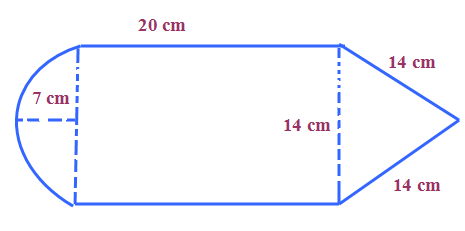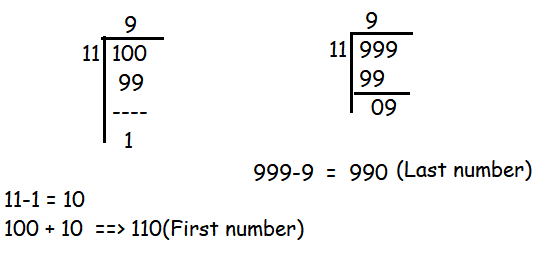MATH PRACTICE TEST FOR 9th GRADE
Problem 1 :
Find the area of the design as shown below.

Solution :
Area of rectangle = l x b
Area of semicircle = πr2/2
Area of equilateral triangle = (√3/4)⋅a2
= πr2/2 + l x b + (√3/4)⋅a2
= (1/2)⋅(22/7)⋅72 + 20 ⋅ 14 + (√3/4)⋅142
= 441.368 cm2
Problem 2 :
A cow is tied to one of the corners of a square-shaped field of sides of 10 m. The length of the rope is 7 m. How would one find the area of the field that the cow cannot graze?
Solution :
Area of square field = 102
Area of the filed that cow can graze = πr2/4
= (1/4) ⋅ (22/7) ⋅ 7 ⋅ 7
= 77/2
Area of the filed that cow can graze = 100 - 77/2
= 61.5 m2
Problem 3 :
Write the number 0.000001024 in scientific notation
Solution :
0.000001024 = 1.024 x 106
Problem 4 :
Write the number 1.423 × 10-6 in decimal form.
Solution :
= 1.423 × 10-6
= 1.423/1000000
= 0.000001423
Problem 5 :
Perform the calculation and write the answer of the following in scientific notation.
(2000)2 ÷ (0.0001)4
Solution :
(2000)2 ÷ (0.0001)4
= (2x103)2 ÷ (1x10-4)4
= (4x106) ÷ (1x10-16).
= 4x106+16
= 4x1022
Problem 6 :
Solve for x
3 = logx729
Solution :
x3 = 729
x3 = 36
x3 = (32)3
x = 9
So, the value of x is 9.
Problem 7 :
Change 2 = 6416 to logarithmic form.
Solution :
2 = 6416
log64 2 = 16
Problem 8 :
Evaluate
log9 (1/27)
Solution :
log9 (1/27)
= log9 (1/3)3
= log9 3-3
= -1log9 3
= -1/log39
= -1/log332
= -1/2log33
= -1/2
So, the answer is -1/2.
Problem 9 :
How many integers between 100 and 999, inclusive, have the property that some permutation of its digits is a multiple of 11 between 100 and 999 For example, both 121 and 211 have this property.
Solution :

110, 121, .........990
n = [(l-a)/d]+1
n = (990-110)/11 + 1
n = (880/11) + 1
n = 81
Number of three digit numbers divisible by 11 is 81.
Each number will consist of three digits, using these three digits we can make 6 possible 3 digit numbers.
81 x 6 = 486
In 486 numbers we have repeated counting.
For example, the number abc is divisible by 11, then cba is also divisible by 11. (Divisibility rule for 11)
So, 486/2 = 243
In those 243 numbers, we may have numbers consisting of one zero.
110, 220, 330, 440, 550, 660, 770, 880, 990
In this way, we can get 9 numbers. If we use the digits in the different places, that will not be divisible by 11 or it must a two digit number.
If the middle digit is 0, then
209, 307, 407, 506 by reversing the digits we will get 902, 703, 704, 605. So 8 numbers.
= 243 - (9+8)
= 226
Problem 10 :
Obtain the set builder representation of the set
A = {1, 1/2, 1/3, 1/4, 1/5, 1/6}
Solution :
A = {x: x = 1/n where n is a integer}
Kindly mail your feedback to v4formath@gmail.com
We always appreciate your feedback.
©All rights reserved. onlinemath4all.com
Recent Articles
-
AP Calculus AB Problems with Solutions (Part - 6)
Jan 15, 25 07:19 PM
AP Calculus AB Problems with Solutions (Part - 6) -
Digital SAT Math Problems and Solutions (Part - 100)
Jan 14, 25 12:34 AM
Digital SAT Math Problems and Solutions (Part - 100) -
SAT Math Resources (Videos, Concepts, Worksheets and More)
Jan 14, 25 12:23 AM
SAT Math Resources (Videos, Concepts, Worksheets and More)